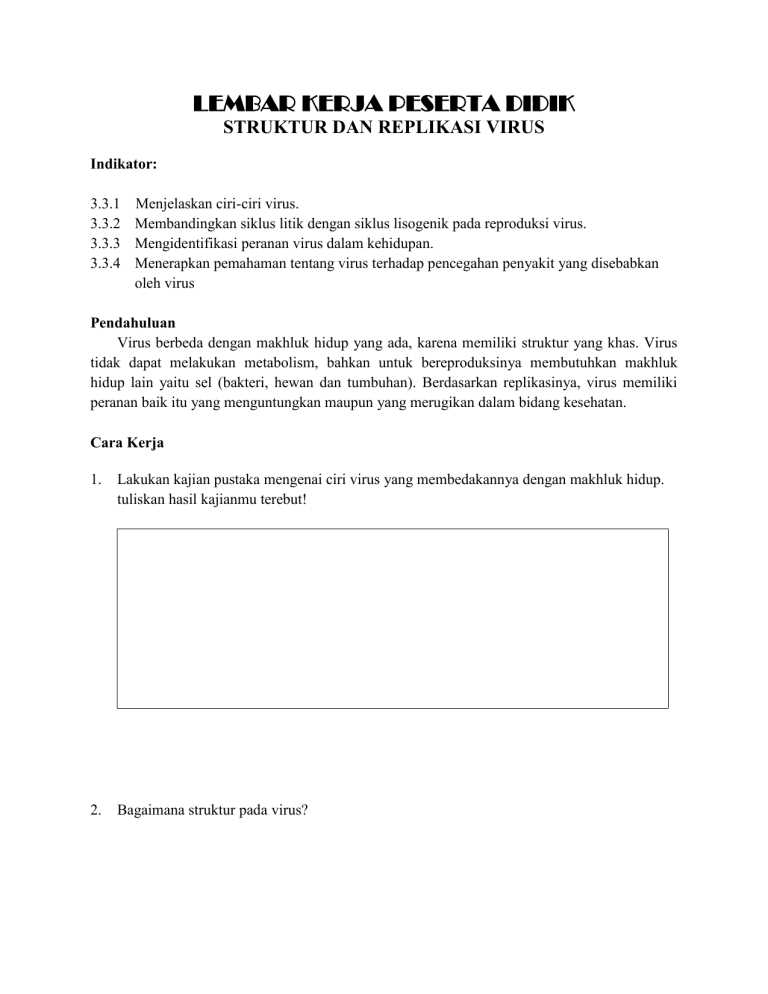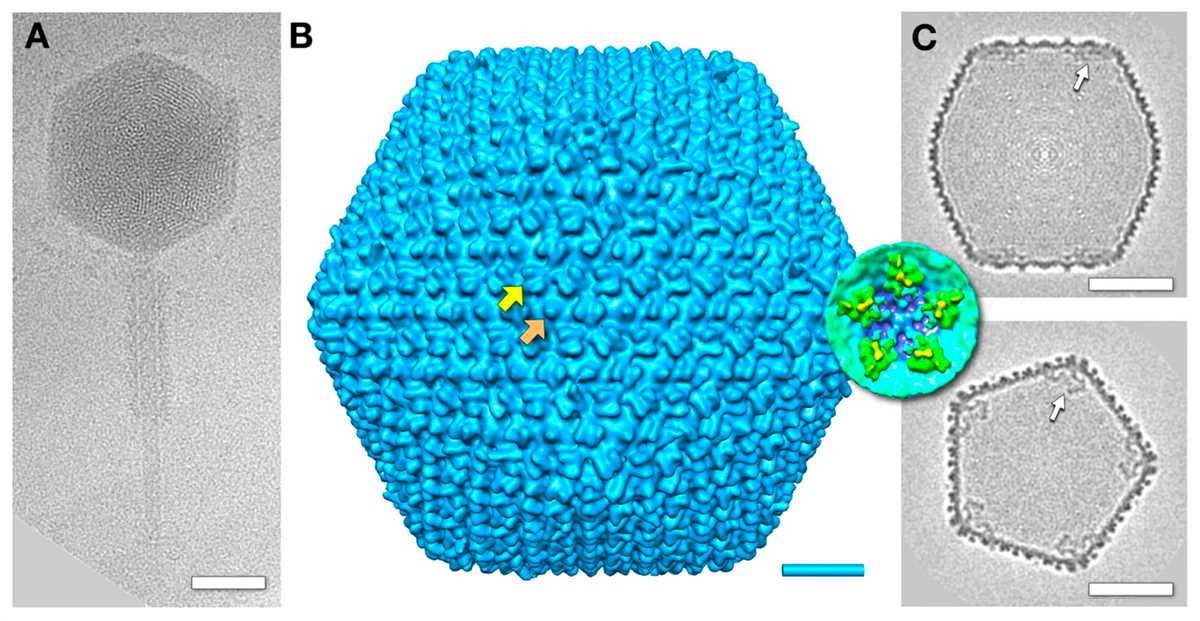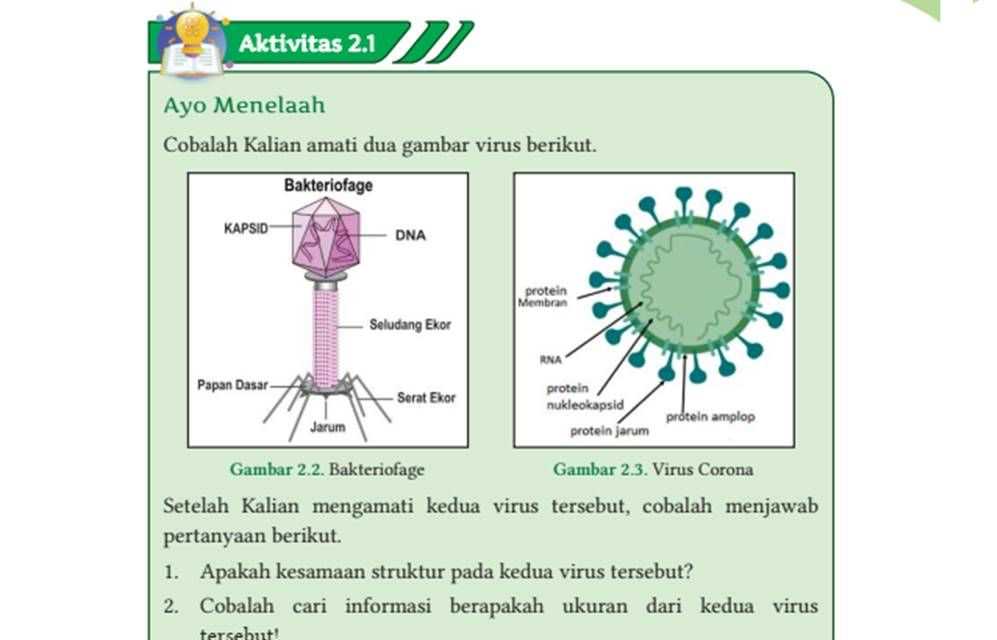
Viruses are microscopic infectious agents that cannot reproduce or carry out metabolic processes on their own. Instead, they rely on host cells to reproduce and multiply. They can infect a wide range of organisms, including humans, animals, and plants. In this article, we will explore the biology of viruses and discuss the key concepts related to their structure, replication, and classification.
Viruses consist of genetic material, either DNA or RNA, enclosed in a protein coat called a capsid. Some viruses also have an envelope, which is derived from the host cell’s membrane. The capsid protects the genetic material and helps the virus attach to host cells. Different viruses have different shapes, such as helical, icosahedral, or complex. Understanding the structure of viruses is crucial for developing antiviral drugs and designing strategies to combat viral infections.
Viruses reproduce by infecting host cells and hijacking their machinery to replicate their genetic material and produce new virus particles. The viral replication cycle typically involves attachment, penetration, replication, assembly, and release. During attachment, the virus recognizes and binds to specific receptors on the surface of the host cell. Once attached, the virus enters the host cell and releases its genetic material. The viral genes then take over the host cell’s machinery to replicate themselves. The replicated genetic material is then assembled into new virus particles, which are released from the host cell, often causing cell death.
What is a virus?

A virus is a type of microscopic infectious agent that can only replicate inside the cells of a living organism. It consists of a genetic material, either DNA or RNA, encased in a protein coat called a capsid. Some viruses also have an outer envelope made of lipids. Viruses are not considered to be living organisms because they lack the ability to reproduce or carry out metabolic processes on their own.
Viruses can infect a variety of organisms, including animals, plants, and even bacteria. They are incredibly small, with the size of most viruses ranging from 20 to 300 nanometers. Despite their size, viruses can cause a wide range of diseases in their hosts, from the common cold to more severe illnesses like influenza, HIV/AIDS, and COVID-19.
Viruses have a unique mode of replication. They must enter a host cell and hijack its cellular machinery in order to reproduce. Once inside the cell, the virus releases its genetic material, which takes control of the cell’s machinery and forces it to make more viral proteins and genetic material. These components then assemble to form new virus particles, which can either be released from the cell to infect other cells or remain within the infected cell until it bursts, releasing the new viruses.
Due to their ability to rapidly mutate and evolve, viruses can often evade the immune system and develop resistance to antiviral medications. This makes them challenging to treat and control. Vaccines have been developed to prevent viral infections by stimulating the immune system to recognize and destroy specific viruses. However, viruses continue to pose a significant threat to human health, and ongoing research is necessary to better understand and combat these infectious agents.
The structure of a virus
A virus is a microscopic infectious agent that replicates only inside the living cells of an organism. It consists of genetic material, which can be either DNA or RNA, enclosed in a protein coat called a capsid. Some viruses have an outer envelope made of lipids. The genetic material of a virus contains the instructions for making new virus particles. In order to replicate, a virus must enter a host cell and take over its cellular machinery.
The capsid of a virus is made up of individual protein subunits called capsomeres. These capsomeres come together to form the capsid, which gives the virus its structure and protects its genetic material. The size and shape of the capsid vary depending on the virus. Some viruses have a simple capsid shape, while others have complex structures with multiple layers. The capsid not only protects the viral genetic material, but it also allows the virus to attach to specific receptors on the surface of host cells.
Some viruses have an outer envelope that surrounds the capsid. This envelope is derived from the host cell’s membrane and contains viral proteins, which are used for attachment and entry into host cells. The envelope allows the virus to evade the host’s immune system and helps it to fuse with the host cell membrane during entry. However, not all viruses have an envelope, and those that do not are called non-enveloped viruses. These non-enveloped viruses are generally more resistant to environmental conditions and can survive outside of host cells for longer periods of time.
Key terms:

- Virus: A microscopic infectious agent that replicates only inside the living cells of an organism.
- Genetic material: The DNA or RNA that carries the instructions for making new virus particles.
- Capsid: The protein coat that encloses the viral genetic material.
- Capsomeres: Individual protein subunits that make up the capsid.
- Envelope: The outer membrane that surrounds the capsid of some viruses.
- Non-enveloped viruses: Viruses that do not have an outer envelope.
How do viruses reproduce?

Viruses are microscopic infectious agents that can only reproduce inside living cells. They are not considered living organisms because they lack key characteristics such as the ability to metabolize or carry out cellular processes. However, viruses have evolved sophisticated mechanisms to hijack the cellular machinery of their host cells in order to reproduce.
When a virus infects a host cell, it injects its genetic material, which can be either DNA or RNA, into the cell. The viral genetic material takes control of the host cell’s cellular machinery and forces it to produce viral components, such as viral proteins and nucleic acids. These viral components are then assembled into new virus particles, called virions.
There are two main mechanisms by which viruses reproduce: the lytic cycle and the lysogenic cycle. In the lytic cycle, the virus immediately starts producing virions and releases them, causing the host cell to burst and die. This can cause severe symptoms and damage to the host organism. In the lysogenic cycle, the viral genetic material integrates into the host cell’s genome and remains dormant for some time. The viral genes are replicated along with the host cell’s genes during cell division, allowing the virus to be passed on to daughter cells. Eventually, the virus may switch to the lytic cycle and start producing virions.
Overall, the reproductive cycle of viruses is a complex and highly specific process that relies on the interactions between viral and host cell components. Understanding how viruses reproduce is crucial for developing strategies to prevent and treat viral infections.
Common types of viruses
Viruses are small infectious agents that replicate inside the cells of living organisms. They are responsible for numerous diseases in humans, animals, and plants. There are various types of viruses, each with its own unique characteristics and mode of transmission.
1. Influenza virus: This virus causes the flu, a highly contagious respiratory illness. It spreads through respiratory droplets when an infected person coughs or sneezes. Influenza viruses are classified into different strains, such as H1N1 and H3N2.
2. HIV (Human Immunodeficiency Virus): HIV infects the immune system, specifically white blood cells called CD4+ T cells. It is transmitted through sexual contact, blood transfusions, and sharing needles. HIV weakens the immune system and leads to acquired immunodeficiency syndrome (AIDS).
3. Herpes simplex virus: There are two types of herpes simplex virus (HSV) – HSV-1 and HSV-2. HSV-1 primarily causes oral herpes, characterized by cold sores on or around the mouth. HSV-2 is responsible for genital herpes, which causes painful sores on the genitals.
4. Hepatitis virus: Hepatitis viruses (A, B, C, D, and E) affect the liver and can cause inflammation. Hepatitis A is usually spread through contaminated food or water, while Hepatitis B and C are transmitted through blood, sexual contact, or from mother to child during childbirth.
These are just a few examples of the many types of viruses that exist. Each virus has its own unique properties and impact on the human body, making them a fascinating subject of study for scientists and medical professionals.
Symptoms and effects of viral infections
Viral infections can cause a wide range of symptoms and effects on the human body. The specific symptoms vary depending on the type of virus, but there are some common signs that indicate a viral infection.
Fever: One of the most common symptoms of viral infections is fever. Viruses invade the body and cause the immune system to produce an immune response, including an increase in body temperature. The fever may be mild or high, depending on the severity of the infection.
Respiratory Symptoms: Many viral infections affect the respiratory system. Symptoms may include coughing, sore throat, runny nose, and difficulty breathing. In severe cases, viral respiratory infections can lead to pneumonia or acute respiratory distress syndrome (ARDS).
Gastrointestinal Symptoms: Some viral infections primarily affect the gastrointestinal system. Symptoms may include nausea, vomiting, diarrhea, and abdominal pain. These symptoms are commonly seen in viral gastroenteritis, also known as the stomach flu.
Fatigue and Weakness: Viral infections can cause profound fatigue and weakness. The body’s immune response to the virus can drain energy and leave individuals feeling exhausted. This fatigue can last for days or even weeks after the infection has resolved.
Rash: Certain viral infections can cause a characteristic rash on the skin. For example, the measles virus causes a red, blotchy rash that typically starts on the face and spreads to the rest of the body. The rash is often accompanied by other symptoms, such as fever and cough.
Neurological Symptoms: In some cases, viral infections can affect the nervous system, leading to neurological symptoms. These symptoms may include headache, dizziness, confusion, and even seizures. Viral meningitis is an example of a viral infection that affects the central nervous system.
Complications: Viral infections can sometimes lead to complications, especially in individuals with weakened immune systems. These complications can include secondary bacterial infections, organ damage, and even death in severe cases. It is important to seek medical attention if symptoms worsen or persist.
In conclusion, viral infections can have diverse symptoms and effects on the body. Recognizing the signs of a viral infection and seeking appropriate medical care is crucial for managing and treating these infections effectively.
Prevention and Treatment of Viral Infections
Viral infections can range from mild illnesses, such as the common cold, to more severe diseases, such as Ebola or COVID-19. While the prevention and treatment strategies may vary depending on the specific virus, there are some general measures that can help prevent the spread of viral infections and mitigate their impact on individuals and communities.
Prevention:
1. Vaccination: Vaccines are one of the most effective ways to prevent viral infections. Vaccination programs have successfully eradicated or reduced the incidence of diseases such as smallpox, polio, and measles. It is important to stay up to date with recommended vaccinations to protect oneself and others.
2. Personal hygiene: Practicing good personal hygiene habits can significantly reduce the risk of viral infections. These include regularly washing hands with soap and water for at least 20 seconds, using hand sanitizers, covering the mouth and nose when coughing or sneezing, and avoiding close contact with infected individuals.
3. Environmental hygiene: Keeping the environment clean and disinfected can help prevent the transmission of viruses. This includes regularly cleaning and disinfecting commonly touched surfaces and objects, such as doorknobs, light switches, and cell phones.
4. Safe food handling: Many viral infections can be transmitted through contaminated food and water. It is important to follow proper food safety practices, such as washing fruits and vegetables, cooking food thoroughly, and avoiding cross-contamination.
Treatment:

1. Supportive care: For most viral infections, there is no specific antiviral treatment available, and supportive care is the main approach. This includes getting plenty of rest, staying hydrated, and taking over-the-counter medications to relieve symptoms such as fever, pain, and congestion.
2. Antiviral medications: In some cases, antiviral medications may be prescribed to treat specific viral infections. These medications work by inhibiting the replication of the virus and can help reduce the duration and severity of the illness. However, they are not effective against all viruses.
3. Vaccines: Vaccines can also play a role in the treatment of viral infections. In some cases, such as with the annual influenza vaccine, vaccines can help prevent complications and reduce the severity of the illness if infection does occur.
4. Experimental treatments: In certain situations, experimental treatments may be available for severe or emerging viral infections. These treatments are usually part of clinical trials and are not widely accessible. They are based on the latest scientific research and aim to identify new effective treatment strategies.
In conclusion, prevention is key in combating viral infections. Vaccination, personal hygiene, and environmental hygiene play critical roles in reducing the spread of viruses. Treatment options vary depending on the specific virus, but supportive care and antiviral medications are commonly used. Continued research and development of vaccines and therapeutic interventions are essential for effectively managing viral infections and protecting public health.